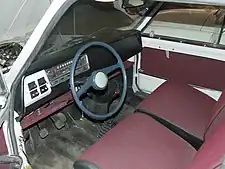FSO Syrena 110
The Syrena 110 was a Polish automobile prototype from the mid-1960s, manufactured by the Fabryka Samochodów Osobowych (FSO) in Warsaw. It was one of the first hatchbacks in the world.
| Syrena 110 | |
|---|---|
 Syrena 110, along with an older Syrena model | |
| Overview | |
| Manufacturer | Fabryka Samochodów Osobowych (FSO) |
| Production | 1965 – 1966 |
| Body and chassis | |
| Class | Compact car |
| Body style | 3-door hatchback |
| Layout | FF layout |
| Powertrain | |
| Engine | 842 cc two stroke straight-3 |
| Transmission | 4-speed manual |
| Dimensions | |
| Wheelbase | 2,400 mm (94 in) |
| Length | 3,955 mm (155.7 in) |
| Width | 1,530 mm (60 in) |
| Height | 1,355 mm (53.3 in) |
| Curb weight | 770 kg (1,700 lb) |
| Chronology | |
| Predecessor | Syrena 104 |
History
In 1961 there started works in the Automotive Industry Construction Bureau (Biuro Konstrukcyjne Przemysłu Motoryzacyjnego, BKPMot) upon a new small family car to replace the FSO Syrena, which was quite new at that time, but was not a modern design. There were built three prototypes, Alfa (rear drive), Beta and Delta (both front drive).[1] At the same, the Construction Bureau of the FSO factory worked upon a new model. In 1964 both teams merged their efforts. The new car was supposed to enter production in 1968.[1]
The car was fitted with a most modern at that time angular-style three-door hatchback body (at the same time, as Renault 16). An interesting design feature was a partial frame in a forward part, enabling dismounting of the whole forward part with an engine.[1] The engine was inherited from the newest Syrena 104 - S-31, 842 cc two stroke straight-3, but a four stroke engine was predicted in the future. A suspension was independent, with spiral springs.[1]
In spite of a generally successful design, only a test batch of less than 20 Syrena 110 was manufactured in 1965-1966.[1] The Syrena 110, that could become a modern and practical popular car, fell victim to a communist planned economy. In view of limited resources of the FSO factory, and neglecting needs for a popular mas-produced car, the Polish authorities decided to cease further works upon the Syrena 110, because of a license agreement to manufacture a mid-class Polski Fiat 125p.[1] Only in the 1970s, after a political change, there appeared a much smaller popular car Polski Fiat 126p. A test batch of Syrena 110 were sold to private hands, and remained in use until the 1980s.[1] At least two cars survived, one in the Motorization Museum in Warsaw (a division of Museum of Technology, Warsaw).

References
- Zakrzewski, Adam (2010). pp.42-43
- Zakrzewski, Adam (2010) (in Polish). Auto-moto PRL: władcy dróg i poboczy, Demart, Warsaw, ISBN 978-83-7427-484-5